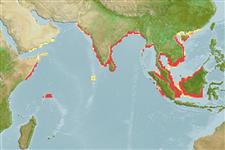Environment: milieu / climate zone / depth range / distribution range
Écologie
marin; saumâtre; amphidrome (Ref. 51243); profondeur 0 - 50 m (Ref. 189). Tropical; 25°N - 5°S, 46°E - 117°E (Ref. 189)
Indian Ocean: Karachi eastward to the Andaman Sea and Penang. Western Central Pacific: Singapore south to Barito River, Kalimantan).
Taille / Poids / Âge
Maturity: Lm ? range ? - ? cm
Max length : 17.0 cm SL mâle / non sexé; (Ref. 189)
Épines dorsales (Total): 0; Épines anales 0; Rayons mous anaux: 80. Body tapering, belly rounded in front of pelvic fins, with 5 to 7 + 9 = 12 to 15 keeled scutes from just behind pectoral fin base to anus. Maxilla almost or just reaching to edge of gill cover. Pectoral fin with 6 long filaments; the branched fin rays longer than those of pelvic fin.
Occurs in fully saline water along coasts and in estuaries, but able to tolerate at least some degree of freshening (e.g. at Aluhaluh on Barito River, Kalimantan). Museum collections suggest that this species is common.
Life cycle and mating behavior
Maturité | Reproduction | Frai | Œufs | Fécondité | Larves
Spawn in school (Ref. 205).
Wongratana, T., T.A. Munroe and M. Nizinski, 1999. Order Clupeiformes. Engraulidae. Anchovies. p. 1698-1753. In K.E. Carpenter and V.H. Niem (eds.) FAO species identification guide for fishery purposes. The living marine resources of the WCP. Vol. 3. Batoid fishes, chimaeras and bony fishes part 1 (Elopidae to Linophrynidae). FAO, Rome. (Ref. 9822)
Statut dans la liste rouge de l'IUCN (Ref. 130435)
Menace pour l'homme
Harmless
Utilisations par l'homme
Pêcheries: pêcheries vivrières
Plus d'informations
RéférencesAquacultureProfil d'aquacultureSouchesGénétiqueElectrophoresesHéritabilitéPathologiesTraitementNutrientsMass conversion
CollaborateursImagesStamps, Coins Misc.SonsCiguateraVitesseType de nageSurface branchialeOtolithesCerveauxVision
Outils
Articles particuliers
Télécharger en XML
Sources Internet
Estimates based on models
Preferred temperature (Ref.
123201): 26.5 - 29.3, mean 28.6 °C (based on 618 cells).
Phylogenetic diversity index (Ref.
82804): PD
50 = 0.5001 [Uniqueness, from 0.5 = low to 2.0 = high].
Bayesian length-weight: a=0.00282 (0.00124 - 0.00641), b=3.10 (2.92 - 3.28), in cm total length, based on LWR estimates for this Genus-body shape (Ref.
93245).
Niveau trophique (Ref.
69278): 3.3 ±0.4 se; based on size and trophs of closest relatives
Résilience (Ref.
120179): Haut, temps minimum de doublement de population inférieur à 15 mois (Preliminary K or Fecundity.).
Fishing Vulnerability (Ref.
59153): Low vulnerability (11 of 100).
